How to move a chair
No matter how dear the furniture is to you, but over the years it wears out and there comes a time when it is no longer possible to use it. Upholstery on sofas, armchairs and chairs is the first to become unusable, it not only becomes outdated, dirty, but also decays. Because of the unsightly appearance, you have to part with your favorite upholstered chairs. If your family has antique furniture that you inherited, then there is a chance to restore it.
To carry out the hauling of chairs, it is necessary to comply with the basic requirement - to preserve the wooden frame, but the final result will depend on the efforts and your desires.
If the chair is not very worn out and scuffs have formed in some places, then you can disassemble it - remove the back and replace the old fabric with a new, suitable shade. If the frame is badly damaged by bark beetles, then such a product can be restored, but the chair is unlikely to be as strong as before, and over time it will still begin to deteriorate and crumble. Carpenters are not advised to start restoring furniture damaged by grinder beetles. Individual elements can be replaced, but if the chair is badly damaged, it makes no sense to restore it.
In the 60-90s of the last century, burlap, felt, cotton wool and hay were used as a filler for upholstered furniture. Even now, some furniture factories continue to use the technology of the 90s in their production, and vegetable fiber is used as a filler for chairs. Over several years of operation, such a natural filler quickly caking, lumps may form in places, as a result of which the upholstery fabric quickly becomes unusable.
How to choose upholstery
When choosing a fabric for a chair upholstery, consider the following:
- the density of the material - it must keep its shape well and be durable;
- the fabric should be easy to wash;
- the ability to treat the surface with soapy water or brush.
Popular fabrics:
- jacquard - dense fabric, has good wear resistance, puffs do not form on it;
- chenille is a popular upholstery material for upholstered furniture. The fabric is very dense and durable;
- tapestry - made of cotton, the material can be washed by hand or in a washing machine;
- nubuck or artificial leather - abrasion-resistant material;
- velvet, flock - the fabric is durable, does not fade;
- leather - "breathes", but is not resistant to mechanical damage (scratches).
How to drag a chair with your own hands
In order for the chair upholstery work to be completed in a short time, think in advance what materials you will need and prepare the appropriate tool.
Instruments
List of materials and tools:
- the cloth. It is best to use furniture fabrics for the upholstery of chairs - tapestry, flock or jacquard. They are abrasion resistant and durable. Before you go to the store for fabric, you need to arm yourself with a centimeter and determine the amount of material. Take measurements of the seat of the chair and add another 10 cm to the figure obtained on each side. This stock will go to the hem, as well as to the height of the upholstery;
- filler. Good recommendations were received by such a filler as sheet foam rubber (thickness no more than 40 mm), you can also use synthetic winterizer, batting or latex as a filler. Bulk materials (buckwheat husks, polyurethane or silicone balls) cannot be taken as a filler for seating a chair, since the load on this part of the chair will be much higher than the load on the pillow. If you use a fine filler, then after a few weeks of operation it will begin to crumble. If foam rubber is chosen as a filler, then its density should be from 30 to 50 kg / m 3. If you use a material of a different density, then the foam rubber will slip and it will be uncomfortable to sit on such a chair;
- thick cardboard to make a pattern;
- glue and brush. It is best to take PVA at a hardware store;
- a stapler and staples for furniture, or a cheaper option - small cloves and a hammer;
- screwdriver;
- pliers;
- tape measure and sharp scissors;
- ruler, pencil, chalk or bar of soap for marking.
How to remove old fabric
Work must begin by removing the old upholstery.
How to properly remove worn fabric:
- First you need to remove the seat. To do this, you need to turn the chair upside down and in a strictly defined sequence (it is advisable to remember the procedure, because then you will have to assemble the chair back) to disassemble the fasteners. First, we pry off the fasteners with a screwdriver, then remove the nails, unscrew the screws and remove the metal lining. The brackets are easy to pry with a screwdriver and pull out with pliers. If they are sewn into disrepair, the staples can be thrown away, and the rest of the fasteners can be put in a separate bag so as not to be lost.
- Now you need to check the condition of the wooden frame of the chair. If it is loose, then reupholstering the furniture will not solve the main problem, the appearance will be beautiful, but sitting on a loose chair will not be safe. Therefore, it is first necessary to eliminate all cracks in the wood (fill it with a colorless sealant or glue it with PVA glue), install clamps, and it is desirable to seal loose joints.
- It's time to remove the old upholstery fabric. Lay plastic sheeting on the floor or lay out old newspapers. Remove the old fabric and carefully remove all the foam. At this stage, you need to determine the measurements of the chairs with your own hands, so do not rush to throw away the worn fabric - you can just make a pattern out of cardboard right away or cut out the seat immediately according to the old model. Lay the old canvas on the wrong side of the new upholstery fabric and trace the outline with chalk.
- Now you need to temporarily put aside the fabric and take up the base of the seat. Remove the remnants of the adhered crumbled foam rubber, remove the old glue.
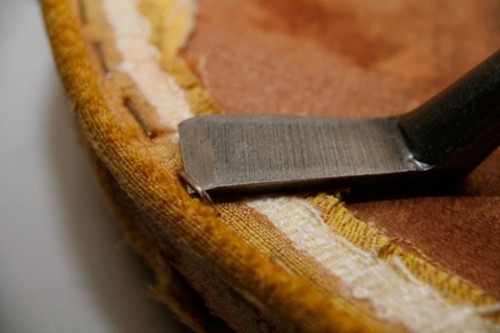
Prepare fabric and foam
Since it will be difficult for a beginner to reupholster a chair without a template, let's just start making it. You can make a template in different ways. The first option: put a plywood seat on a sheet of cardboard, circle it with a pencil. Now the plywood can be removed, and in our drawing, add 10 cm on each side for allowances. Cut out the template with scissors or a sharp utility knife. The second option: we will use the ready-made template and attach the old fabric to a sheet of cardboard, circle the outline with a pencil. This will be our template. Choose the right option for you and make a seat template.

We have a ready-made stencil - you can cut out the desired part from a foam rubber sheet with a sharp knife. By the same principle, we make a fabric template: draw around the contour and add another 10 cm on each side (let it be better to have a small supply of fabric than not enough). Cut out the detail.
If you have chosen a fabric with a pattern, then it is necessary at the initial stage - the acquisition of fabric, to take this moment into account and take the material with a margin. Lay the fabric with the pattern so that it is in the middle and there are no offsets. If this rule is not observed, then the chair will not look presentable. Now you need to fix the fabric and markup.
In some chairs, instead of the usual plywood seat, you can see a frame made of mesh or rubber. When the wicker base is normal, then nothing needs to be done, if the material has become unusable, then it must be replaced with dense wide rubberized tapes.
How to move a chair
First, glue the foam to the plywood. Foam rubber is glued to PVA glue. On the front (upper) part of the plywood seat, apply a layer of glue with a brush and attach the foam rubber. Wait for the glue to set. Upholstery work can be started after the glue has completely dried.
When the glue dries - check again if the foam rubber has stuck well - if there are not glued places, then it is advisable to fill them with glue and wait for it to dry completely again. After that, you can fix the upholstery fabric. Lay it wrong side up, put the seat on top so that the foam is located "face" to the fabric. On each side, tuck the fabric (this is stock) onto the plywood. Stretch the material tightly so that the fabric does not gather in folds. Now take a furniture stapler and shoot the edges of the fabric to the plywood. Work sequentially, in increments of no more than 2 cm. Large folds should not form between the staples. If you see that large folds form in the places of rounding, and the furniture brackets do not hold them, then you can strengthen these places with furniture studs. Hit the carnations with a hammer. Excess fabric can be cut off after the stool is finished.
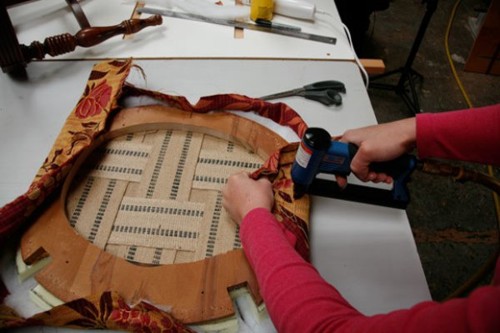
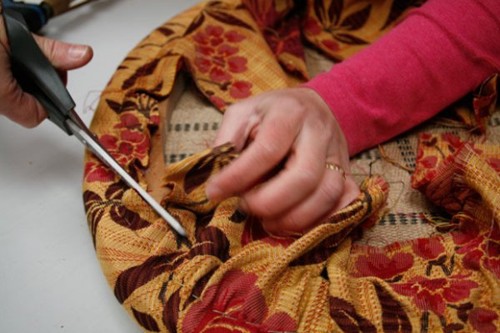
If you are pulling a square chair seat, then you need to lay folds in the corners and direct them to the center, bend the fabric, and then attach to the plywood.
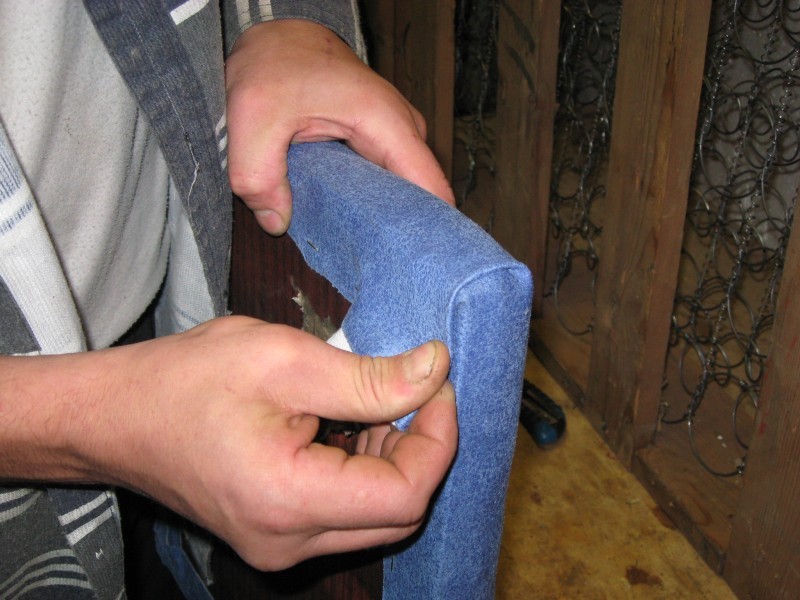
We install the drawn seat of the chair back onto the frame, first attach the plates, and then fasten the screws. The do-it-yourself chair upholstery is complete. This is what the restored chair looks like:
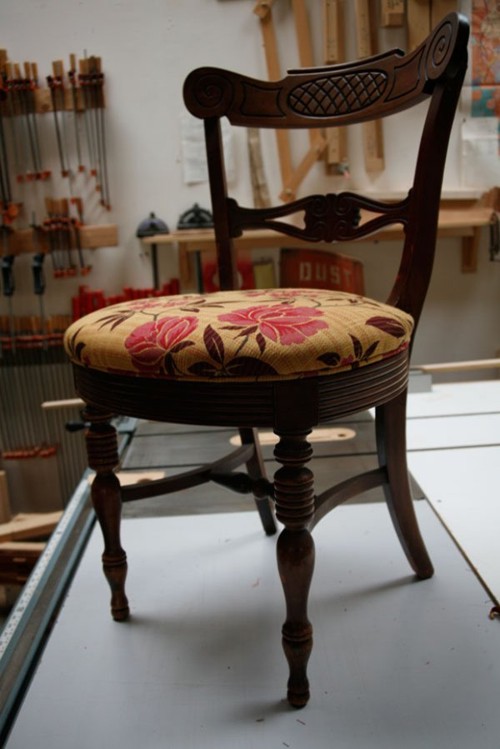
How to drag a chair, you can watch this video:
What else to read
THE LAST NOTES
- DIY rocking chair (59 photos): drawings, convenient options, tips for creating
- Cover for a chair with a backrest with your own hands - patterns plus fantasy
- DIY rocking chair: materials and drawings with dimensions
- Do-it-yourself bumpers in the crib: a manifestation of parental love and care
- An excellent design solution to make a built-in wardrobe from hl
